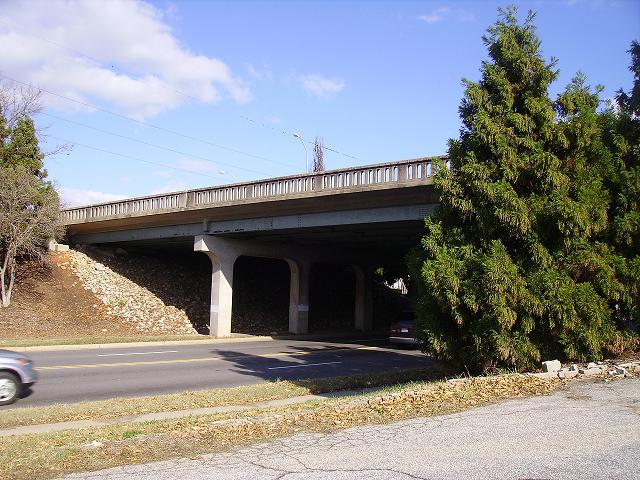It’s the gateway to the downtown area, and it’s in need of repair.

The Peace Street bridge could be renovated in 2016.
The Peace Street bridge could soon get a much-needed makeover, thanks to the North Carolina Department of Transportation (NCDOT).
But bridge changes could mean big problems for Peace Street businesses open for decades, including Finch’s diner.
Necessary Repairs
The NCDOT is considering renovations to bridges on both Peace Street and Wade Avenue.
According to the NCDOT website, the Peace Street bridge, built in 1948, has a sufficiency rating of 42.9 out of 100. Both the Peace Street and Wade Avenue bridges are described as “structurally deficient and functionally obsolete.”
NCDOT Planning Engineer Vince Rhea said the bridges are in “good shape, or usuable shape, but they are reaching the end of their useful life, and so it’s time for them to be replaced — both of them.”
The bridge also has a very old design. Raleigh Transportation Planning Manager Eric Lamb said the loops are substandard and are “not what we would build today.”
Rhea said both bridges are important because Capital Boulevard is “one of the main arteries to downtown.”
Traffic at the Capital Boulevard and Peace Street intersection was 54,000 vehicles per day in 2009. That’s expected to increase to 77,000 vehicles per day by 2035.
Lamb said the Peace Street bridge is more of a gateway corridor than a gateway bridge and it becomes what he called a “lynchpin” in the discussions of the various street construction projects that are taking place around that area.
Where It Stands
Right now, the project is in the preliminary stages of development. State engineers are working on an environmental document, which is necessary for federal funding.
A public hearing on the project is slated for fall 2012, with right-of-way purchasing planned for 2015 and construction projected to start in 2016.
Link: The NCDOT has more detail about the project.
There are currently three proposed designs for the bridge, which include either a diamond, square-loop or bowtie interchange.
City officials like the square-loop interchange option because it gives access to the side streets and there aren’t as many impacts as the other options. Lamb said that design has a “whole lot of advantages” from a land-use and traffic operations pattern.

The square interchange is one option for making over the Peace Street bridge. Photo courtesy of NCDOT.
Rhea said based on input from a September workshop, the public “hasn’t really had a whole lot of preference for one or the other, so it’s probably going to come down to a combination of cost and what we think will serve the traffic best.”
NCDOT Project Engineer Derrick Weaver said the cost for the Peace Street bridge project is estimated to be $14 to 15 million. He said the funding will come from a mix of local, state and federal funding, but most of it will come from the federal fund specifically for bridges.
Construction Impacts
The project could have an environmental impact on Pigeon House Branch Creek.
“It’s one that’s been impacted unfortunately a lot in the past, but we’ll be watching out for that,” Rhea said.
Meanwhile, Peace Street business owners are paying close attention to find out if their buildings will stay or go.
Some potentially historic properties could be impacted, like the mill near the bridge, which is now condominiums, and Finch’s Restaurant, which is being studied to see if it qualifies for the historic register.
“If it’s eligible, then you have to give it special consideration,” Rhea said. “It may not change the overall effect of the project, but we’d have to deal with it differently.”
Grass Roots Press, Finch’s next-door neighbor, would also be affected by the project. Owner Gary Cappy said the business has resided in the building since 1988.
Cappy thinks that a new bridge is needed, but he does not like the fact that the business will probably have to move.
“From looking at the plans, it looks like basically this building will be torn down,” Cappy said. “I don’t know whether they’re going to build over it. I doubt it.”
He said Finch’s started in the 1950s and Watkins shoe store opened in the 1970s. Cappy said that while Anderson Supply, which he said was started 75 years ago, would be impacted “while maybe not driven out of business, the construction alone is going to cause them a lot of headaches.”
Rhea said engineers will look at the effects of the construction with an eye to lessen or mitigate business impact. But Lamb said the impact on Finch’s is “virtually unavoidable” in any bridge project because its side wall is connected to the retaining wall.
Cappy said construction is delayed all the time, and most businesses will stay as long as they can.
“Our feeling isn’t that we’re trying to stop progress. We don’t want to stop progress,” Cappy said. “We need a new bridge, we want bridges replaced, we want work done, but we also don’t want to be kind of forgotten in the process.”
Public response to the project, Rhea said, has been mixed, but has mostly been positive.
“There’s been a few negative comments from some of the business owners that would be acquired under the project that don’t really want to be and that’s understandable, but by and large, the response has been pretty positive,” Rhea said.
